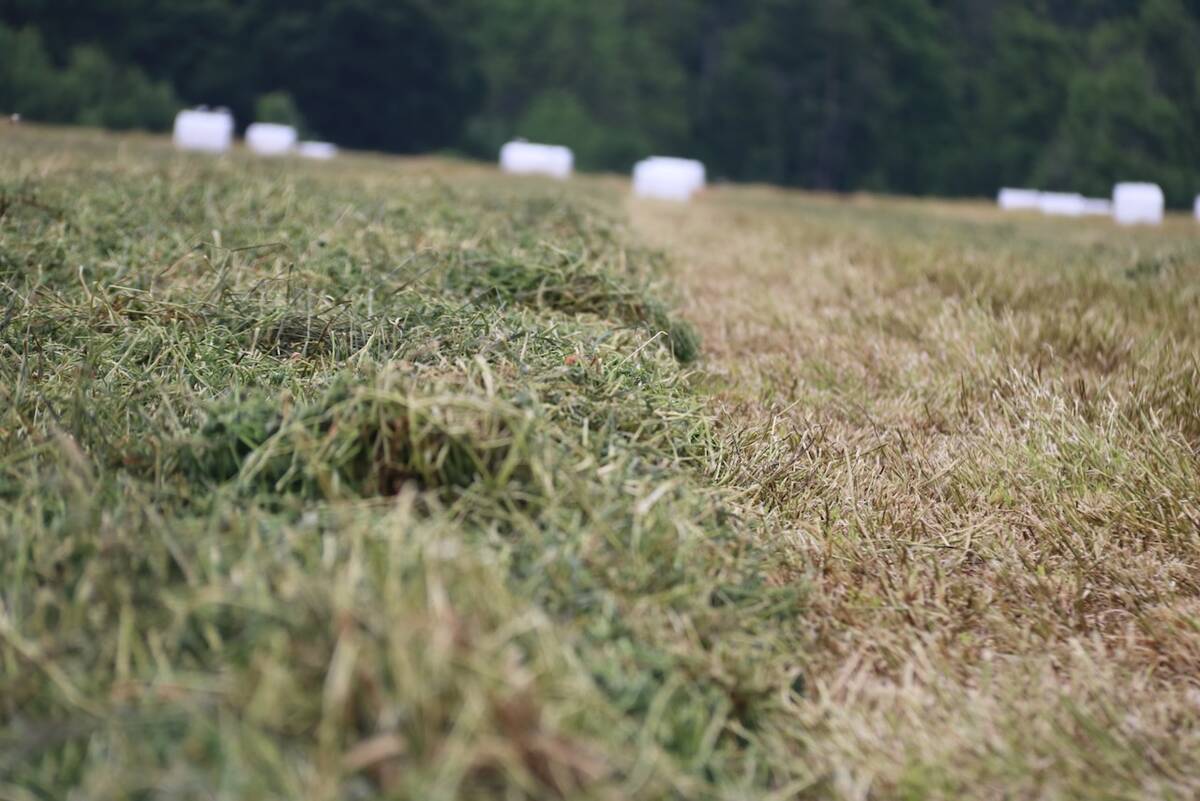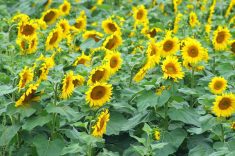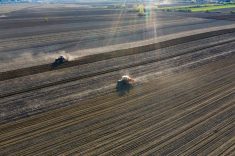Better yields come from healthy soils. Of five main attributes of highly productive fields, four are a direct result of optimum soil health and not agronomic decisions. Here’s what you can do to build better soil
In an effort to find out why certain fields or areas of fields consistently produce higher yields I discovered that there are certain field characteristics which contribute to the ability to produce more yield. The characteristics of consistently high production areas are: elevated levels of soil biology; better water infiltration; lower bulk density; deeper topsoil depth; and, balanced fertility. The challenge is to implement a strategy to achieve these soil qualities on as much of the land base as possible.
Elevated levels of soil biology
Soil biology is what soil scientists refer to as the living organisms in the soil. These living organisms are part of the food web in the soil. To understand what the food web in the soil is, think of a web that is all connected together with each strand supported not by just one other strand but with multiple strands. Healthy soil organism functions depend on all the other organisms in the soil. This interconnected system is healthier and stronger when there is greater biological diversity. The question that farmers should ask themselves is how to increase this diversity and build higher levels of soil biology.
Read Also

New high-performance forage training program to launch in 2026
A new Canadian Forage and Grasslands Asssociation high-performance forage program will be a resource for farmers, agronomists and others in the forage sector.
Some soil biologists refer to the life in the soil as the “soil herd.” The “soil herd” is more likely to keep working for you when there are many different species of organisms to do the work of turning plant residue into plant -available nutrients. Soil organisms will also help break down some chemical residues and beneficial predator organisms that are working on your behalf to keep the pest population of diseases, insects and pathogens in check. Soil biology is increased when we maximize crop residues, rotate with different crops, and reduce the amount of tillage of the soil. The amount and type of crop residue that is returned back to the field will have an effect on the organisms. Some organisms will prefer root biomass from sod and other organisms will prefer pea stubble or cereal straw. Tillage incorporates plant residue into the soil and can stimulate some microbial activity in the short term but repeated tillage reduces the level of organic matter in the soil that supports the food web. There are agronomic and economic limitations to incorporating too many different crops into the crop plan but the opportunity is there when you want to try to elevate the levels of soil biology and provide a habitat for some of the organisms in the soil that may be missing.
Better water infiltration
Precipitation that runs off or ponds in the field does not provide much benefit to the crop. Fields that have good water infiltration rates will capture more of the precipitation during the growing season and supply more of that moisture to the growing crop. Fields with poor water infiltration are more prone to erosion. Erosion is a loss of applied nutrients and farther downstream water quality issues.
Fields that allow water to pond lose much of the water to evaporation which means it is not available to the crop. Fields that have poor water infiltration are prone to crusting and can cause problems with root growth during the growing season and crop emergence at establishment. Soil organisms do not flourish in soils that crust over. Crusted soil does not have the porosity to allow water and air to flow through.
To see the differences in water infiltration rates in your fields you may want to do some infiltration rate testing. One method would involve taking a piece of three-inch plastic pipe about two feet long and standing it upright in the field and filling it with water from a two-gallon jug. The faster the water soaks into the ground from the pipe the better the water infiltration. By doing this test in different fields and in various crops you can see that soil with good residue cover or sod will have better water infiltration than bare soil or fields that always receive frequent tillage. Growing crops in the rotation that provide greater amounts of residue can help improve field water infiltration.
Lower bulk density
Bulk density is the measurement of how compacted the soil is. Some soil compaction is necessary for good seed-to-soil contact and germination, soil that is too loose allows water to evaporate too quickly. Fields with a high bulk density or compaction have restricted root growth, reduced soil organism habitat and water movement is limited in the soil.
Compaction or high bulk density is caused by a number of farming practices; every time we drive a piece of equipment across the field we are increasing the bulk density in those tracks. A track made when the soil is wet causes easier compaction because the moisture in the soil has replaced the air pockets that cushion it, just squeezes the soil together and makes that track very hard. In areas that have received high amounts of rainfall prior to and during the growing season are in a situation where every equipment pass is going to contribute to areas of compaction in the field. Reducing field traffic or limiting it to designating traffic lanes can help greatly to prevent field soil compaction. Fields that have a lower bulk density produce higher yields than those with compaction zones.
Deeper topsoil depth
One indicator of crop yield potential is the depth of topsoil, or the A horizon of the soil profile. Good, deep topsoil is the foundation for building better yields. To increase topsoil depth, generate higher levels of plant material returned to the field. We have been told that topsoil builds downward and not accumulated upward and that it takes thousands of years to build an inch of topsoil. What these scientists are talking about is the chemical weathering and mechanical breakdown of rock surfaces.
The process of topsoil building that farmers can do involves an intensive management process that first starts with eliminating soil erosion practices and swings to an accumulation of material in the soil. Most of this accumulation of material is going to come from plant residue, animal manure and other biosolids. Consider practices that protect the topsoil that is already present. Treat topsoil as one of the most valuable assets in the farming operation. Evaluate the land and determine if there is anything that is causing soil erosion or loss of soil from the field and do what is necessary to eliminate that loss. Plant and maintain grassed waterways to prevent water erosion. Establish buffer strips along ditch banks and field borders. In areas of the field where topsoil is eroded or not as deep as other areas the water infiltration rate is limited and availability of water to the crop is reduced. Precipitation is subject to surface water run off. From what I have seen in the field those that have a topsoil depth greater than six inches have a greater chance of producing more yield than those fields with less than six inches. Especially in years of extreme low moisture and in years of higher levels of moisture.
Balanced fertility
From looking at soil sample results over the last number of years and seeing what the yield history on these fields is, I have seen that fields with a generally higher level of fertility have a history of higher yields. Having too much of some nutrients and not enough of others in the soil limits the yield potential of the crop to the potential of the limiting nutrient. From the “Nutrient Uptake and Removal by Field Crops” chart from the Canadian Fertilizer Institute, we know the uptake requirements of nutrients for the crops that we are growing and if those nutrients aren’t there when the crop needs them the yield potential is limited. Fields with above-adequate fertility can take advantage of better growing conditions and are not as likely to have an accumulation of stresses combined with environmental factors.
Look at fertilizer application as a long-term investment that pays dividends over many growing seasons. Higher-yielding fields do not suffer from micronutrient deficiencies during periods of environmental stress, they have more than adequate amounts of these important nutrients required to grow the crop.
Evaluate your own farm and the productivity of the fields and determine which factors are limiting yield potential and implement a strategy to improve the quality of the land. It may involve modification of cropping system with a greater variety of crops in the rotation, reducing the amount of tillage on fields and increasing the return of crop residues back to the field. Feed the soil with more green material from living crops. Soil test and bring up nutrient levels from adequate or sufficient to higher levels than just crop removal rates. Reduce field compaction by controlling field traffic or eliminating unnecessary passes with field equipment. Fields with higher levels of soil biology, better water infiltration, lower bulk density, deeper topsoil depth and balanced fertility will show a greater return on investment and build higher yields. †














